Archive for the 'Fruit' Category
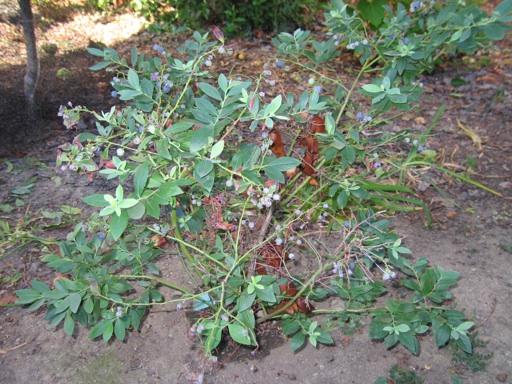
The surprise for me was learning that blueberries would even grow in California. About two years ago, I learned about Southern Highbush blueberries, which are a group of blueberries that were bred to grow and produce fruit in mild weather climates such as USDA zone 9. Southern Highbush Blueberries were developed in Florida. They include varieties with names such as O’Neal, Misty, Jubilee, Southmoon, and Sunshine. The one pictured above is a Sunshine bush growing in my yard.
I added a special acid soil mix to the planting sites and then supplemented with sulfur, because blueberries prefer acidic soil (pH 5.0-6.0). I planted about 7 bushes. They produce berries from June through August. They look healthy. But some of the plants produce a very small harvest (maybe 20-30 berries). And other plants produce many tiny berries.
Whenever a heat wave hits, the new growth gets sunburnt and wilts. Even when the weather is mild, the plants grow very slowly, even though they are getting regular watering from a drip system. Maybe I need to fertilize them more.
Despite the problems, I think they are a great addition to my garden. In this area, they are a novelty. I have never seen them growing in anyone else’s garden in the Bay Area. Plus, the berries are tasty and are great in pies and on cereal.
July 27 2008 | Blueberries | Comments Off on Blueberry Surprise
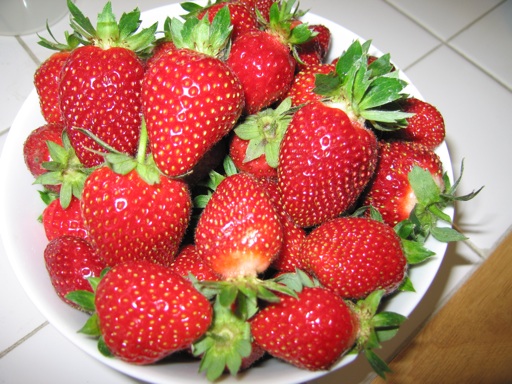
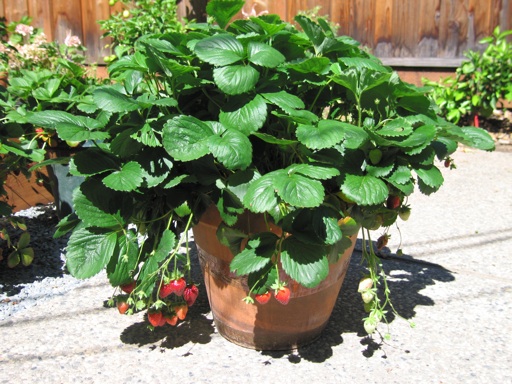
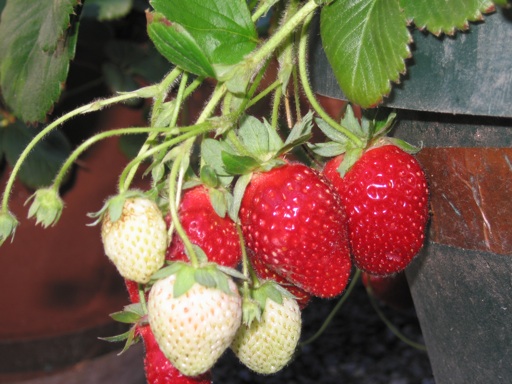
I have had a lot of luck growing Sequoia June-Bearing Strawberries in pots. Right now, they are full of ripe strawberries. The berries are so much tastier than what I typically purchase in a grocery store.
When I grew strawberries in the ground, snails ate the berries before they even turned red. I was reluctant to put snail poison near the fruit, and it washed away quickly anyway. A few years ago, I started growing strawberries in pots that have copper tape around the bottom. I have had very few problems with snails since then.
Back in May, I was harvesting strawberries every week. Then in June, the June-Bearing strawberries suddenly stopped producing strawberries, even though I was watering every few days, and they looked healthy otherwise. Usually, the plants wilt if they are not getting watered at least that often.
I then tried fertilizing them with water soluble fertilizer every week. In about 3 weeks, the plants started getting the white flowers again, and now they are producing berries in abundance. I think that the nutrients may have leeched out of the soil in the pots.
Also, the plants are probably root bound in the pots and competing for nutrients and water. I probably put too many in each pot, although they don’t seem to mind as long as they are getting watered and fertilized regularly.
July 27 2008 | Strawberries | Comments Off on June-Bearing Strawberries
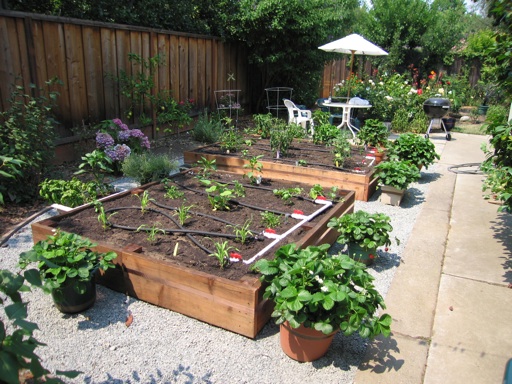
Last week, I converted a lawn in my side yard into a vegetable garden. The garden includes two raised beds made of 12” x 2” untreated redwood. One bed is 6’ x 7’, and the second bed is 8’ x 6’. I decided not to make the beds wider than 6’ so that it would be easy to reach the plants without walking in the garden. The wood is secured into the ground with 4” stakes in each corner that are embedded in cement like fence posts.
Each garden bed is surrounded by 2’- 2.5’ wide gravel paths that have weed block underneath to make the plants more easily accessible.
Each bed has four soaker hoses that are set on a timer to water daily. Each of the eight soaker hoses has a red shut off valve. Each shut off valve can be turned on or off to supply water to the soaker hose. In the wintertime, I may decide to grow plants in only a portion of the garden. So I added the shut off valves to have the flexibility to water only the portion of the garden that has plants.
I haven’t had a vegetable garden since I was a child. Back then, my parents filled in an old sandbox with dirt, and we started growing vegetables. My sister and I had a lot of fun each summer taking care of the plants and watching them grow. We had fun watching the plants grow quickly and produce fruit within only a few months in the warm spring and summer weather.
Last week, my mom and I planted a variety of warm weather vegetables, fruits, and herbs. We planted a six pack of corn, 3 tomatoes, 5 peppers, 3 eggplant, 6 basil, 3 groups of cilantro, a six pack of onions, one set of zucchinis, and one set of cantaloupes. Because I am getting the garden started relatively late, I bought mostly larger seedlings to give them a head start. After planting, I gave them a thorough watering and shot of water soluble fertilizer.
The next day I put adhesive copper tape around the wooden perimeter of each of the raised beds. The copper tape helps to keep the snails and slugs out of the garden. They don’t seem to cross the copper tape. I have had a lot of luck using copper tape to keep snails out of my strawberry pots. It’s a great organic way to deal with snails without having to use pesticide near edible produce.
July 13 2008 | Fruit and Vegetables | Comments Off on New Vegetable Garden
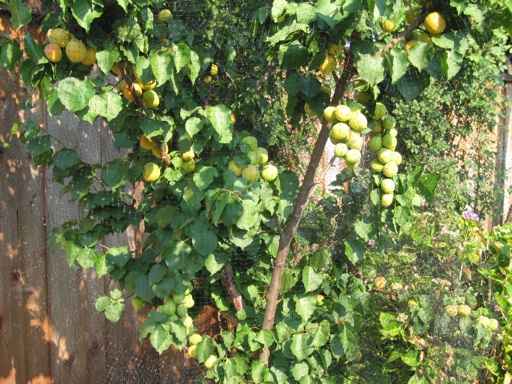
Blenheim apricot tree with netting
I have fond memories of picking apricots from our Blenheim apricot tree in the summertime when I was growing up. We would eat them fresh, and my mom would cook apricot cobbler and apricot jam.
The fruit on the Blenheim apricot tree in my backyard is ripening this week, and they taste delicious. The fruit is very sweet with only a hint of tartness. Tree-ripened Blenheim apricots are the best tasting apricots. By tree-ripened, I mean apricots that are left on the tree until they are not only orange in color, but soft to touch. When the surface of the fruit is mostly hard when squeezed, it is not ready yet. Ideally, an apricot should be left on the tree until it is soft enough to make a small dent in the flesh. Usually, an apricot becomes soft enough to eat about week after beginning to turn orange.
Blenheim apricots often are not completely orange even when ripe. The side of the apricot that is exposed to the sun tends to turn orange, while the side of the apricot that is shaded from the sun may be a bit green or yellow, although the inside is soft and sweet. A Blenheim apricot will often have a characteristic greenish or yellowish cast on one side that distinguishes it from many of the commercially sold apricots that one finds in a grocery store.
I have heard that one of the reasons that fresh Blenheim apricots are rarely sold in grocery stores these days is because customers rarely select them due to their non-uniform color. Also, Blenheim apricots tend to rot a few days after they ripen. So, they do not have a long shelf life, and they are unsuitable for transport over long distances. That’s too bad, because Blenheim apricots are really the best tasting apricots in my opinion. It seems that the only way you can get them anymore is by growing a tree in your backyard.
Squirrels are the main problem I have had with growing apricots. Squirrels love apricots. They take them off the tree just as they are beginning to turn orange, before I consider them to be ripe. Squirrels in my area will strip all of the fruit off a tree in a matter of days. The only solution that works is to wrap the tree with bird netting. Every winter I trim the tree down to a height of about 10 feet tall. Fruit trees do not develop fruit on newly grown branches. Therefore, topping the tree to 10 feet ensures that the tree only develops fruit on the lower branches.
I only need to net the lower part of the tree, which requires a lot less effort than netting the full canopy. I use clothes pins to secure the net to the branches, and make sure that the net is wrapped around the inside branches as much as possible so that the squirrels can’t access the fruit by jumping past the net into the inner branches. Also I wrap part of the net around the trunk, and tie it with string so they can’t crawl up the trunk through a gap in the net. I have hardly lost any apricots to squirrels this way!
Blenheim apricots grow great in California. But because they bloom early (e.g., the first week of March in our area in 2008), they are hard to grow in regions that are prone to late frosts. A late frost could damage the blossoms or newly developing fruit.
July 13 2008 | Apricots | Comments Off on Blenheim Apricots Ripening
« Prev





